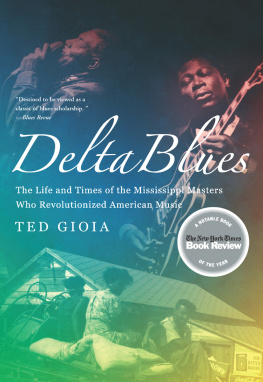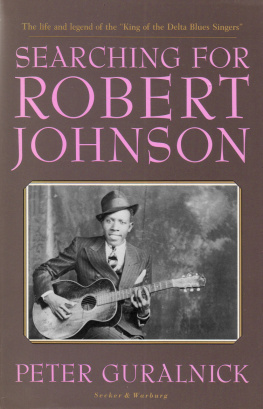Table of Contents
PRAISE FOR MARYBETH HAMILTONS In Search of the Blues
Hamilton offers a book worthy of consideration and debate, a well-written and researched inspection of blues, bluesmen, and American mythmaking.
Paste Magazine
Author Marybeth Hamilton comes to the fold as a welcome naysayer. She claims that one of the accepted cornerstones of blues historythat the musics earliest recorded rural practitioners were part of a shared and exclusive style, Delta bluesis not only wrong but the result of distortions by white middle- and upper-class song hunters who cast themselves as the discoverers of this music and built a mythology around it.
Boston Phoenix
Hamiltons book is a must-read for anyone interested in the blues, the social conditions of its discovery, and questions concerning music and authenticity. Her narrative is engaging and informative, her understanding acute and persuasive. For all of the answers it provides, the books most important achievement resides within the questions that it raises.
Pop Matters
In Search of the Blues is fascinating. Hamilton has done noble work. Blues aficionados with too much time on their hands, too many CDs on their walls, and too much disposable income for R. Crumb prints and rare 78s (like a Robert Johnson Hellhound on My Trail that recently went for $9,000) will find reasons to quibble, but thatas it has been since Howard Odum made his first trip into the fieldis all part of the game.
Times Union, Albany
Its easy to take for granted that such blues giants as Son House, Charlie Patton, Robert Johnson, and Leadbelly were always accepted as such. This provocative book is a new, often fresh examination of how those songwriting performers, and others like them, actually found that worldwide recognition.
American Songwriter (Three Stars)
The real gem among these profiles... is that of James McKune, a record collector who went radically in the other direction, denying any social import and insisting on a purely aesthetic appreciation of the music. But pure aestheticism is just another mythology, and Hamilton shows that in their myth-building, these searchers unintentionally revealed more about themselves than about the objects of their obsessions.
Harp Magazine
High Fidelity excepted, books about record collectors are pretty rare, but heres one, and its brilliant.... An instant classic.
Record Collector
Who says that taste is only personal and cannot be disputed? The cultural canon is always up for revision, and received wisdom has a shelf life. This is made clear in Marybeth Hamiltons In Search of the Blues, an intriguing study of white scholarly attempts to discover and define the Real Blues. Like the figures in that childrens story, they kept taking a part for the whole, and most often discovered a distorted version of themselves. But they also convinced a lot of people that they were deeper and wiser than anyone else, and that if you disagreed you were a shallow if not a bad person.
Truth Dig
[Hamiltons] brief but provocative book doesnt aim to question the artistic accomplishments of the spectral Delta bluesmen, whose recordings might all too easily have slipped from view. But it shakes the foundation myth of so much in music that followed, as well as explaining a great deal about what it is to be a record collector, itself a dying calling in the age of the iPod, when every kind of music from every age is digitally accessible.
Observer (UK)
Wherever you happen to light in Marybeth Hamiltons In Search of the Blues you find Columbusthe discovery of America in the drama of Americans discovering each other. Its no matter that its the twentieth century, not the fifteenthblacks and whites are strangers, so white people turn into detectives and black people into fugitives, shadows on the wall or hiding in plain sight. In this book, you never know how any story is going to turn out, and as the story goes on the suspense builds up.
Greil Marcus
In Search of the Blues renders, in shimmering prose, superb field recordings of the blues searchers themselves, revealing why they searched, what they found, and how their humble, obsessed pursuits helped change the world.
Sean Wilentz
Marybeth Hamilton is a detective pursuing other detectivesthe motley group of characters who, over the course of the twentieth century, bit by bit uncovered the mysteries of the blueswho are, as it turns out, both so many Schliemanns at Troy and so many blind men circling the proverbial elephant. Hamiltons story is riveting, her prose is elegant and concise, and her insights about the music, race relations, and the mechanics of cultural transmission are unfailingly acute.
Luc Sante, author of Low Life: Lures and Snares of Old New York
For Jackson and Lukas
one
The Delta Revisited
ON OLD HIGHWAY 61 IN MISSISSIPPI, BETWEEN LULA and Robinsonville in the heart of the Delta, stand the remains of a wooden railroad bridge partially submerged in a murky swamp. The air enveloping the bridge is sticky and fetid, thick with the smell of decayed vegetation, and the dark, stagnant water stretches far into the distance, flooding the banks, engulfing the trees. To look at the scene is to peer at an eerie, apparently timeless landscape, primordial and untouched by history, the world Noah might have glimpsed after the flood.
I photographed this bridge in May 1999 while driving south through the Mississippi Delta, aware all the while of following a well-worn trail. The trek through the Delta in search of the roots of the blues has been a trope of music writing since the early 1960s, the opening years of the blues revival, when white Americans and Europeans rediscovered a music that African Americans had long left behind. My aim in coming to the Delta was, I thought, more sophisticated: to get a handle on the pilgrim experience, to reconstruct the breathless hunt for the authentic origins of the blues. And yet here I was, slamming to a halt on a desolate highway, bewitched by the sight of that decaying bridge, transported into what felt like a mystical landscape, a world frozen outside the passage of time.
This mythology of the Delta arose with the land itself. The regions first boosters, in the early twentieth century, portrayed it as a place outside history. Though it had only just been opened for agricultureas late as 1860, 90 percent of the Delta was covered in swampsby 1910 railroad developers had enveloped it in the romantic imagery of the Old South. Nowhere in Mississippi have antebellum conditions of landholding been so nearly preserved as in the Delta, rhapsodized the owners of the Illinois Central Railroad. The Negro is naturally gregarious in instinct, and is never so happy as when massed together in large numbers, as on the Delta plantations.
This idea of the Delta as the Old South reincarnate, with its nostalgic evocation of mint juleps and magnolia blossoms, took on a more sinister cast in the mid-1930s, as northern anthropologists flocked to the region. Those observersJohn Dollard, Hortense Powdermaker, Allison Davispainted a stark, vivid portrait of a land of unparalleled brutality, marked by naked extremes of wealth and destitution and by caste domination in its most blatant forms.












